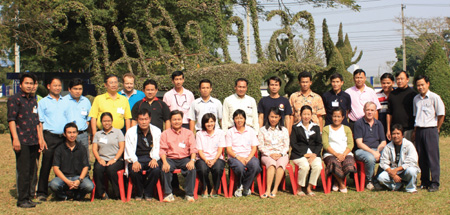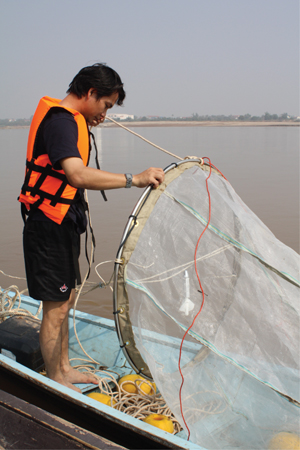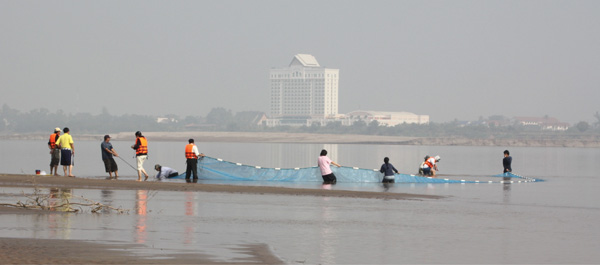Identifying significant fish spawning grounds
along the Mekong mainstream
By Suchart Ingthamjitr and Buoy Roitana*
A regional survey of fish larvae has started at 11 sites along the Mekong mainstream. The results are expected to help policymakers make informed decisions about the costs and benefits associated with hydropower development

Survey personnel at a December workshop
organised at the Nongkhai Inland
Fisheries Research and Development Centre in Thailand.
Photo: Suchart Ingthamjitr
The recent focus on mainstream dam development has prompted the MRC Fisheries Programme to undertake a series of fast-tracked activities to improve regional understanding of the impacts of such projects on fisheries in the Lower Mekong Basin (see Catch and Culture, Vol 14, No 2). These activities include a survey of the geographical and seasonal distribution of fish larvae at 11 sites along the mainstream of the Mekong stretching from Luang Prabang to the Delta. The 12-month survey aims to identify significant spawning grounds that may be affected by mainstream dam development. It involves researchers from all four countries of the Lower Mekong Basin and has been designed with the assistance of Professor Ian Cowx of the Hull International Fisheries Institute. The Royal Thai Department of Fisheries is the focal point for auditing, storing and archiving the samples. In addition to larvae and juvenile collection, the survey will collect supplementary data such as water level, water velocity and water quality parameters like temperature, turbidity, pH and dissolved oxygen. Indigenous local knowledge of spawning areas will be collected by questionnaire.
Sampling stations

Following two preparatory meetings and a five-day workshop during the second half of 2008, the survey is now underway. Larval sampling at six upstream stations in Lao PDR and Thailand started in February followed by five downstream sites in Cambodia and Viet Nam in March.
Sampling at each station will take place every second month over the course of the year. Sampling stations Although most Mekong fish species spawn during the wet season, yearlong sampling is necessary since some flagship species, such as the Mekong giant catfish (Pangasianodon hypophthalmus) and the Isok barb (Probarbus jullieni), spawn in the dry season.
Bongo nets and seine nets
The survey involves sampling fish larvae with bongo nets and
juvenile fishes with seine nets. Hand-held plankton nets are
also being used in various habitats such as backwaters, shallow
inshore areas, weed beds and rocks.
The bongo nets have a conical length of 5 m with a mesh size of 1 mm and a mouth opening of 100 cm in diameter. The large mouth is based on experience with similar sampling in the region which shows that a bigger opening increases the time the net can be set before it becomes clogged during the flood season.
Ideally, larval distribution in the water column should be taken into account and a stratified depth sampling strategy carried out. However, this is considered unrealistic during the Mekong flood season and impractical when using bongo nets from a pontoon or boat at a fixed location. The nets are therefore being set in the littoral zone of the river close to the shore at a depth of 2 m from the surface. This is both for safety reasons (it is too dangerous to sample mid-channel in the flood season) and because most larvae tend to drift close to the banks where the water is marginally less turbulent. Sampling by bongo net is taking place at six-hour intervals over a 24-hour period with a flow meter placed in the mouth of each net to quantify the volume of water being filtered. The sampling period is likely to last 10-15 minutes during the flood season and as long as 30 minutes or more in the dry season. If catches are low, duplicate samples are being taken.
| Province or municipality | Location of station |
|---|---|
| Luang Prabang (Lao PDR) | Ban Sain Suok, northern Luang Prabang town |
| Nong Khai (Thailand) | Ban Hua Sai, Sri Chiang Mai district |
| Nakhon Phanom (Thailand) | Ban Tha Dog Kaew, Tha Utain district |
| Ubon Ratchathani (Thailand) | Ban Khoum, Khong Chiam district |
| Champasak (Lao PDR) | Ban Khon Lay, 4-5 km from Pakse |
| Champasak (Lao PDR) | Ban Don Sadam, 3-4 km below Khone Falls |
| Stung Treng (Cambodia) | Kang Memay village, 4-5 km south of Stung Treng town |
| Kratie (Cambodia) |
Thmor Kreleu village, 4-5 km north of Kratie town |
| Phnom Penh (Cambodia) | Chong Chroy village, 8-10 km north of Phnom Penh |
| An Giang (Viet Nam) | Vinh Xuong, Mekong River |
| An Giang (Viet Nam) | Quoc Thai, Bassac River |

Practising bongo net sampling at the
Nongkhai workshop
Photo: Suchart Ingthamjitr
The survey is also using seine nets in marginal areas to sample juvenile fishes more effectively and provide greater information about the growth and recruitment processes in different sections of the river in relation to habitat variability. The seine nets are 25 m long and 3 m deep with a 3-mm knot-to-knot mesh. At each site, two sweeps of the net are being made in different locations reflecting backwater or slow flow conditions. The seine nets are sampling a slightly different component of the fish community in that larger specimens are likely to be caught.
* Dr Suchart and Mr Roitana are the MRC Fisheries Programme officers responsible for coordinating the survey
![]()

Practising seine net operation at
the Nonghkai workshop
Photo: Suchart Ingthamjitr
Choose a newsletter: